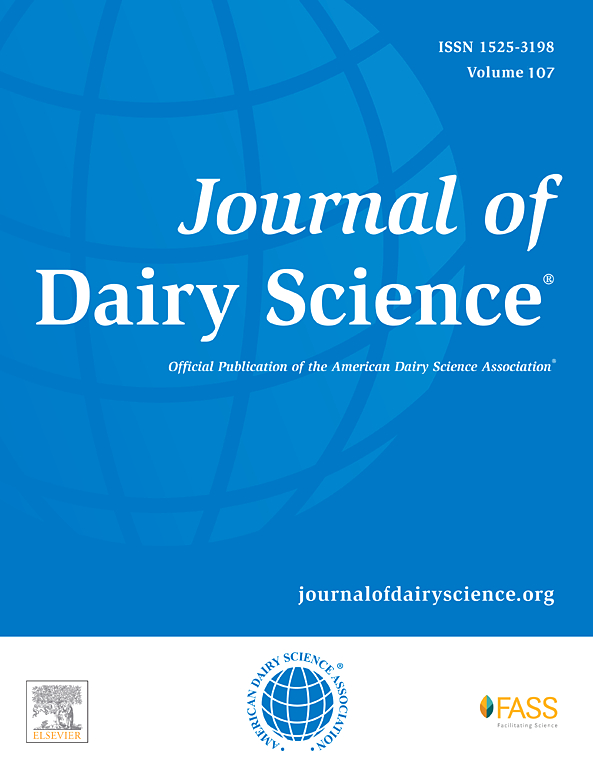日粮主要营养成分组成以及用缓释尿素替代部分豆粕:对奶牛生产性能、消化率、瘤胃发酵和氮代谢的影响。
IF 4.4
1区 农林科学
Q1 AGRICULTURE, DAIRY & ANIMAL SCIENCE
引用次数: 0
摘要
采用 2 × 2 因式排列处理,研究日粮主要营养成分组成[高淀粉、低脂肪、低纤维(HsLFF)比低淀粉、高脂肪、高纤维(LsHFF)]和氮源[豆粕(SBM)或部分用缓释尿素(SRU)替代]对奶牛泌乳性能、瘤胃发酵、氮利用效率、营养物质消化率、血液代谢物和采食行为的交互影响。采用 4 × 4 拉丁正方形重复设计,涉及 12 头多胎荷斯坦奶牛(产奶量为 40.5 ± 5.6 千克/天,体重为 590 ± 20 千克;产奶期为 81 ± 12 天)。HsLFF 日粮含有 300 克/千克淀粉、31.3 克/千克脂肪和 301 克/千克 NDF,不含秸秆或额外脂肪。相反,LsHFF 日粮含有 195.5 克/千克淀粉、60.8 克/千克脂肪和 367.5 克/千克 NDF,添加了小麦秸秆(100 克/千克)和额外脂肪(34 克/千克)。日粮配方为等氮等热。与饲喂LsHFF日粮的奶牛相比,饲喂HsLFF日粮的奶牛具有更高的DM摄入量、DM和CP消化率、产奶量和乳蛋白率,但NDF和物理有效NDF摄入量以及乳脂率较低。用SRU代替SBM可显著提高乳固体产量,而不影响其他泌乳性能或体重。与 HsLFF 日粮相比,饲喂 LsHFF 日粮的奶牛瘤胃 pH 值和支链 VFA 比例较高,但总 VFA 浓度较低,而饲喂 LsHFF-SRU 日粮的奶牛瘤胃氨水平最高。与HsLFF日粮相比,饲喂LsHFF日粮的奶牛的NE摄入量、乳能输出量和维持所需的能量都较低,但各组之间的能量平衡相似。HsLFF 日粮提高了氮的利用率,从而提高了牛奶中的氮含量,降低了粪便中氮的排泄量。血液代谢物研究表明,主要因素之间存在显著的相互作用,尤其是血糖和肌酐,饲喂 LsHFF-SRU 和 LsHFF-SBM 日粮的奶牛血糖和肌酐水平最低。此外,饲喂 LsHFF 日粮的奶牛的丙氨酸氨基转移酶水平高于饲喂 HsLFF 日粮的奶牛。这可能表明,由于高脂肪、低淀粉日粮引起的代谢失衡,会改变能量代谢,从而导致早期肝脏应激。采用 HsLFF-SRU 日粮的奶牛血糖水平最高,表明碳水化合物代谢可能发生了变化或代谢率较高。LsHFF日粮饲喂后,BUN浓度稳步上升,LsHFF-SRU日粮饲喂4小时后达到峰值,HsLFF日粮中不同氮源的BUN浓度无差异。用 SBM 部分替代 SRU 对 BUN 没有影响。主要因素之间的交互作用对 MUN 含量有显著影响,LsHFF-SRU 的 MUN 含量最高,而 HsLFF-SRU 的最低,HsLFF 日粮中不同氮源之间没有差异。总之,虽然减少淀粉、增加纤维和脂肪的日粮会影响泌乳性能,但用 SBM 部分替代 SRU 有助于维持产奶量和乳氮效率。然而,LsHFF-SRU 日粮的氮利用效率较低,这表现在瘤胃氨、BUN 和 MUN 水平较高。本文章由计算机程序翻译,如有差异,请以英文原文为准。
Dietary macronutrient composition and partial soybean meal replacement with slow-release urea: Effects on performance, digestibility, rumen fermentation, and nitrogen metabolism in dairy cows
A 2 × 2 factorial arrangement of treatments was used to investigate the interactive effects of dietary macronutrient composition (high-starch, low-fat, low-fiber [HsLFF] diet or low-starch, high-fat, high-fiber [LsHFF] diet) and N source (soybean meal [SBM] or partially replaced by slow-release urea [SRU]) on lactation performance, rumen fermentation, N utilization efficiency, nutrient digestibility, blood metabolites, and feeding behavior in cows. A replicated 4 × 4 Latin square design was used involving 12 multiparous Holstein cows (milk yield of 40.5 ± 5.6 kg/d, BW of 590 ± 20 kg; 81 ± 12 DIM). The HsLFF diet contained 300 g/kg starch, 31.3 g/kg fat, and 301 g/kg NDF, without straw or additional fat. In contrast, the LsHFF diet contained 195.5 g/kg starch, 60.8 g/kg fat, and 367.5 g/kg NDF, enriched with wheat straw (100 g/kg), and additional fat (34 g/kg). The diets were formulated to be iso-nitrogenous and isocaloric. Cows fed the HsLFF diet had greater DM intake, digestibility of DM and CP, milk yield, and milk protein percentage, but lower intakes of NDF, and physically effective NDF, and milk fat percentage than cows fed the LsHFF diet. Replacing SBM with SRU significantly increased milk solids yield without affecting other lactation performance or BW. Cows fed the LsHFF diet had higher ruminal pH and branched-chain VFA proportions but lower total VFA concentrations compared with the HsLFF diet, while those on the LsHFF-SRU diet had the highest ruminal ammonia levels. Compared with the HsLFF diet, cows fed LsHFF had lower NE intake, milk energy output and energy requirement for maintenance, although energy balances were similar among groups. The HsLFF diet improved N utilization, resulting in higher N content in milk and lower N excretion in feces. Blood metabolite studies showed significant interactions between the main factors, particularly for blood glucose and creatinine, with the lowest levels in cows fed the LsHFF-SRU and LsHFF-SBM diets. In addition, alanine aminotransferase levels were higher in cows fed the LsHFF diet than in cows fed the HsLFF diet. This could indicate early-stage liver stress due to the metabolic imbalance caused by a high-fat, low-starch diet, which can alter energy metabolism. Cows on the HsLFF-SRU diet had the highest glucose levels, indicating possible changes in carbohydrate metabolism or a higher metabolic rate. The concentration of BUN increased steadily after feeding in the LsHFF diet and peaked after 4 h in the LsHFF-SRU diet, with no difference between N sources in the HsLFF diet. Partial replacement of SRU with SBM had no effect on BUN. The interaction between the main factors had a significant effect on MUN content, which was highest in LsHFF-SRU and lowest in HsLFF-SRU, with no difference between the N sources in the HsLFF diets. Overall, while diets with reduced starch and increased fiber and fat compromised lactation performance, partially substituting SRU with SBM helped maintain milk production and milk nitrogen efficiency. However, the LsHFF-SRU diet was less efficient in N utilization, as shown by higher levels of ruminal ammonia, BUN and MUN.
求助全文
通过发布文献求助,成功后即可免费获取论文全文。
去求助
来源期刊

Journal of Dairy Science
农林科学-奶制品与动物科学
CiteScore
7.90
自引率
17.10%
发文量
784
审稿时长
4.2 months
期刊介绍:
The official journal of the American Dairy Science Association®, Journal of Dairy Science® (JDS) is the leading peer-reviewed general dairy research journal in the world. JDS readers represent education, industry, and government agencies in more than 70 countries with interests in biochemistry, breeding, economics, engineering, environment, food science, genetics, microbiology, nutrition, pathology, physiology, processing, public health, quality assurance, and sanitation.
 求助内容:
求助内容: 应助结果提醒方式:
应助结果提醒方式:


